It’s beyond sad to learn how many dogs end up in shelters and on euthanasia lists. The situation in the States is somehow manageable, but there are still so many dogs waiting to be rescued, yet so many dogs ending up on such lists.
The truth is ugly: euthanasia lists still exist because some dogs are simply…hopeless.
Animal shelters are not all sugar, spice, and everything nice. It’s not only what you see in the movies: a kennel with happy pups waiting to be adopted. Some cases are too problematic to be solved.
Some dogs arrive malnourished, neglected, and heartbroken. Losing faith in hoomans is the worst thing a dog could experience.
During my many years as a volunteer in my local animal shelters, I saw everything. Sometimes, you just have to swallow a bitter pill and turn your head the other way because there’s nothing you can do.
But, none of those cases broke my heart the way Edie did. When I saw a video of her being rescued off the list, I felt my heart shattering into pieces. Faith in humanity was restored.
Edie’s Salvation
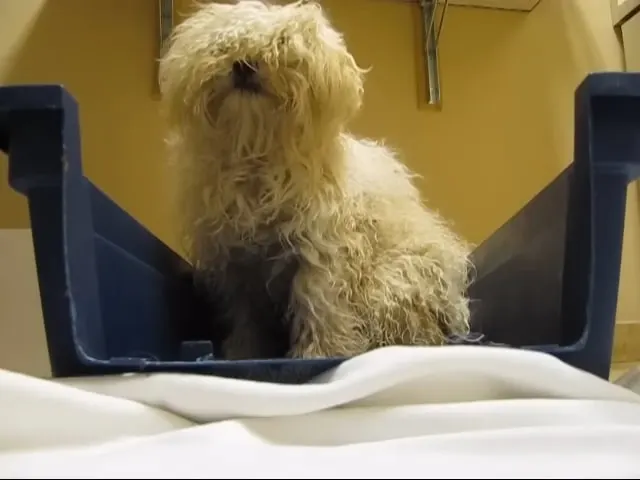
When Edie, a fuzzy-haired white girl, arrived at the Hope For Paws shelter in Lancaster, she was in terrible condition: malnourished, all tangled up, and suffering from a lack of trust. Edie was labelled as an aggressive dog, and we all know how such dogs end up.
Potential adopters always skip dogs that have behaviour issues. The reason is simple: working with them demands a whole new level of care, professionalism, and dedication.
But, someone from above said Edie should not be written off that easily.
Despite being marked as aggressive, one of the volunteers saw potential in Edie just an hour before falling asleep forever.
When Eldad Hagar found out there was a dog like Edie in their shelter that was about to be put under, he knew he had to react and give her a second chance. Eldad believed in her even when Edie believed everything was coming to an end.
Cornered, with fear striking from her eyes, and hopeless yelps escaping her tiny body, Edie stood there crying for help. She did not like it when Eldad put a leash around her neck.
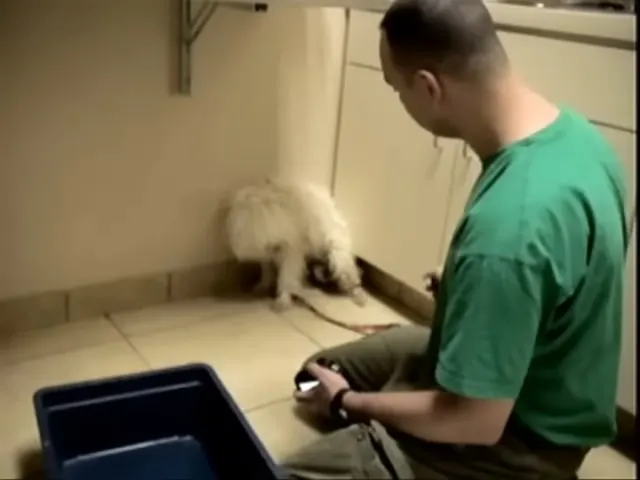
Edie fought like never before, afraid Eldad was just one more human there to hurt her.
It took a few janks and Eldad was finally able to reach out, grab Edie, and put her in his lap.
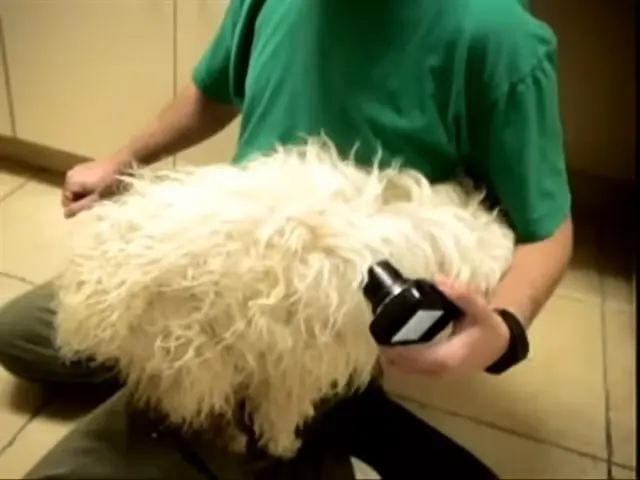
Time froze for a second. A flash of recognition ran across Edie’s face as she realized Eldad was not there to harm her; he was there to show her love… something she almost forgot existed.
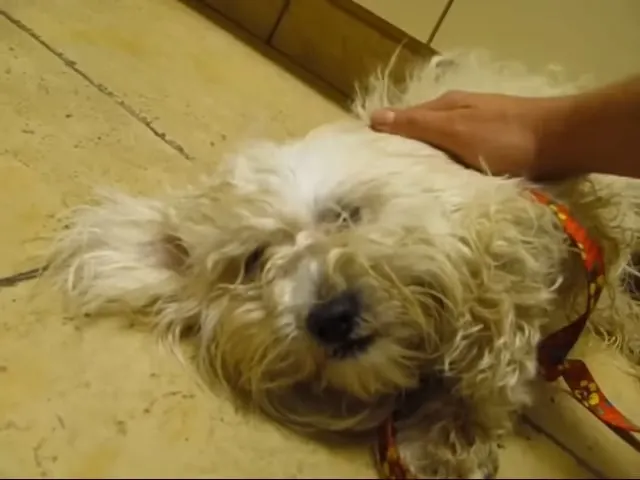
Edie calmed down within seconds. As the volunteer stroked her fuzzy hair, Edie’s whole body relaxed, and she invited Eldad to give her more cuddles. It didn’t take long for Edie to roll over and offer her belly for scratches.
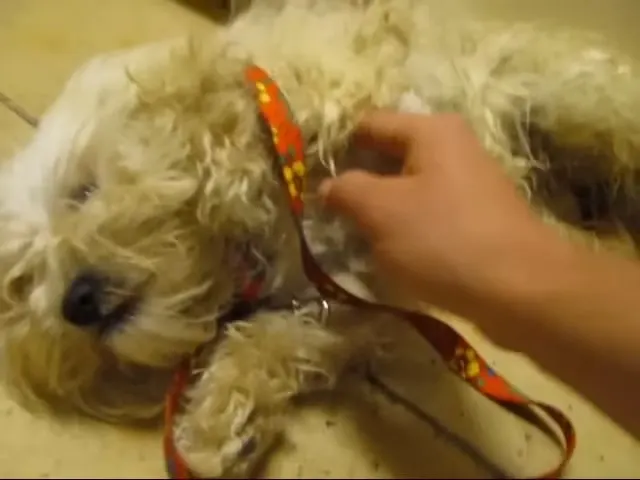
The poor, fluffy, mixed-breed dog went from being scheduled for euthanasia to being rescued miraculously.
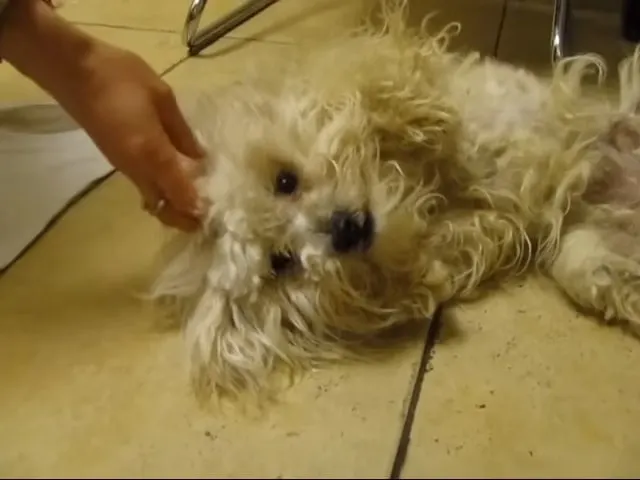
Prepare yourself because what you’re about to see are Edie’s final moments as a written-off pup. Watch for her priceless reaction when she sees those helping hands stroking her.
Edie’s Furever Home
Just a week later, after being saved in the last moments of overtime, Edie was actually adopted!
Thanks to the good people at Home For Paws, Edie found her furever home. One of the volunteers at the shelter reported that Edie was adopted into a loving family in San Marino, California.
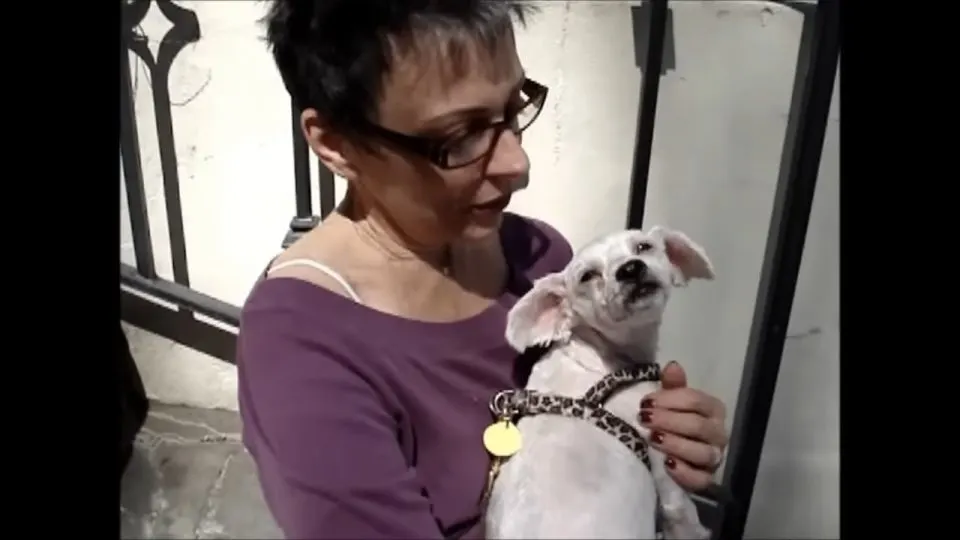
Fifteen days at the shelter in Lancaster helped this Maltese Poodle mix restore faith in humanity. Edie felt like a brand-new dog. She looked like one, too!
Once sentenced to eternal sleep, this doggie got what she deserved: a home.
RELATED: Edie is adopted update – Bronwyne Mirkovich
Although Edie’s story is not one of the freshest, I still can’t help myself but tear up a bit. These are real-life proofs that not everything is as it seems. Everyone deserves a second chance and a life filled with love.
Ever noticed your furry friend enthusiastically rolling around in the grass? It’s a common sight that often leaves you wondering what’s going on in their playful minds. Dogs, with their curious and quirky behaviors, never fail to surprise us. Rolling in the grass is not just a random act; there’s more to it than meets the eye.
For your canine companion, that lush green carpet isn’t just a spot for relaxation but a playground of scents and sensations waiting to be explored. So, the next time your pup decides to indulge in a grassy roll, remember, there’s a whole world of canine enjoyment waiting to be discovered right beneath their paws.
Exploring the Canine Mind: Understanding Why Dogs Roll in the Grass
Theories Behind the Rolling Behavior
Dogs rolling in the grass may stem from their ancestral roots when they needed to mask their scent for hunting. This behavior could be an instinctual way for dogs to bring different scents back to the pack, acting as a disguise to help with the hunt. So, the next time your furry friend rolls in the grass, they might not be trying to get dirty but rather tapping into their primal instincts.
A Sensory Experience for Dogs
Rolling in the grass is like a sensory adventure for dogs. The grass’s texture against their fur and the variety of scents it holds make it an exciting experience for them. Dogs have an incredible sense of smell, so rolling in the grass allows them to soak in all the scents and information around them. It’s like a canine spa day, where they get to indulge in a symphony of smells unique to the outdoor environment.
In essence, the next time you see your dog luxuriating in a roll in the grass, remember, it’s not just playtime—it’s a sensory escape for them, connecting them to their instincts and the world around them in a special way.
The Science of Scents: Examining How Dogs Interact With Odors
Marking Their Territory
Dogs have a natural instinct to mark their territory, and rolling in the grass is one way they do this. By rubbing their scent onto the grass, they communicate with other dogs, letting them know they’ve passed through the area. It’s like leaving a little note saying, “I was here.”
Obscuring Their Scent
Rolling in the grass also helps dogs obscure their own scent. In the wild, predators rely on their sense of smell to track prey. By covering themselves with different scents from the environment, dogs make it harder for potential prey to detect them. It’s like putting on a disguise before going out on a mission.
The Joy of Rolling: Considering a Dog’s Pleasure in Grass
Playfulness and Predatory Instincts
Dogs rolling in the grass isn’t just about getting clean; it’s a playful act deeply rooted in their predatory nature. When your furry friend dives into the grass, it’s like embracing their inner hunter. This behavior connects them to their ancestors who relied on scent camouflage for successful hunting.
The Influence of Texture and Temperature
The texture and temperature of the grass play a significant role in your dog’s rolling activities. The coolness of the grass on a warm day can be refreshing, while different textures may provide varied sensory experiences. Dogs might choose to roll in certain types of grass based on how it feels against their fur.
Remember, when your dog is rolling in the grass, it’s not just a random behavior – it’s a meaningful and instinctual activity that brings them joy and connects them to their primal instincts.
Health and Wellness: When Rolling in Grass Indicates Potential Issues
Indications of Skin Problems
Sometimes, when your furry friend repeatedly rolls in the grass, it might be a signal of underlying skin issues. Constant itching or irritation could lead your dog to seek relief by rolling in the grass to alleviate discomfort. If you notice persistent rolling accompanied by redness, sores, or bald patches on your dog’s skin, it’s essential to consult with a veterinarian to rule out any potential skin problems.
A Sign of Digestive Discomfort
In some cases, dogs may roll in the grass as a response to digestive problems. If your dog experiences stomach upset, indigestion, or nausea, they might roll in the grass to ease their discomfort. Keep an eye out for other signs such as vomiting, diarrhea, or changes in appetite alongside excessive rolling. Consulting with your vet can help determine if the rolling is linked to an underlying digestive issue that needs attention.
Addressing and Managing Grass Rolling in Dogs
Training Approaches to Reduce Unwanted Behavior
To manage your dog’s grass rolling habit, training is key. Start by redirecting their attention when they begin to roll. Use commands like “sit” or “stay” to shift their focus away from rolling. Reward them with treats or praise when they follow your commands instead of rolling. Consistency is crucial; practice these training techniques regularly to reinforce the desired behavior and discourage excessive grass rolling. Over time, your dog will learn to respond to your cues, reducing the frequency of this behavior.
Knowing When to Seek Veterinary Advice
While occasional grass rolling is normal, excessive or compulsive rolling may indicate an underlying health issue that requires veterinary attention. If you notice your dog rolling excessively, especially accompanied by signs like persistent itching, redness, sores, or digestive upset, it’s essential to consult a veterinarian promptly. These behaviors could be linked to skin problems, allergies, parasites, or digestive issues. Your vet can conduct a thorough examination to diagnose any underlying conditions and recommend appropriate treatment to address your dog’s discomfort. Taking early action can help manage your dog’s health effectively.
Conclusion
Now that you understand why your furry friend enjoys rolling in the grass, you can better appreciate their natural instincts and behaviors. Remember, while occasional rolling is normal, excessive rolling might be a sign of underlying health issues. By using positive reinforcement techniques and seeking guidance from your vet, you can help manage your dog’s grass-rolling habits effectively. Keep an eye out for any unusual symptoms like itching, redness, or sores, and consult a professional if needed. With the right approach, you can ensure your dog stays happy, healthy, and content in their grassy adventures.
Frequently Asked Questions
Why do dogs roll in the grass?
Dogs roll in the grass as a way to engage with their surroundings and connect with their primal instincts. It can also help mask their scent to potentially avoid predators or communicate with other animals through scent marking.
When should I be concerned about my dog rolling in the grass?
If your dog excessively rolls in the grass or shows signs of itching, redness, sores, or digestive upset, it could indicate underlying health issues. Consult a vet if these symptoms persist to rule out skin problems, allergies, or gastrointestinal discomfort.
How can I manage my dog’s grass-rolling behavior?
You can train your dog to redirect their attention from grass rolling using commands and positive reinforcement. Reward desired behaviors like walking calmly on a leash or responding to commands to help deter excessive rolling tendencies.
[no_toc]

Hey there, I’m Janet Brooks, a dog-loving student from California. I’m all about helping pups in need, especially those without homes. Me and my awesome friends work together to give shelter and love to stray dogs. Oh, and I also write blogs about dogs to share helpful info.